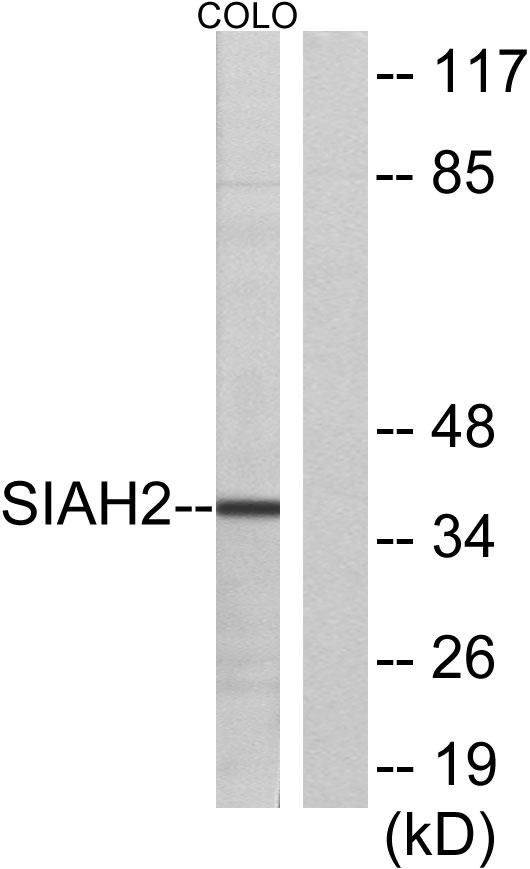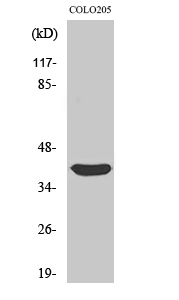产品名称
Siah-2 Rabbit Polyclonal Antibody
别名
SIAH2; E3 ubiquitin-protein ligase SIAH2; Seven in absentia homolog 2; Siah-2; hSiah2
蛋白名称
E3 ubiquitin-protein ligase SIAH2
存储缓冲液
Liquid in PBS containing 50% glycerol, 0.5% BSA and 0.02% New type preservative N.
Human Gene Link
http://www.ncbi.nlm.nih.gov/sites/entrez?db=gene&term=6478
Human Swissprot No.
O43255
Human Swissprot Link
http://www.uniprot.org/uniprotkb/O43255/entry
Mouse Gene Link
http://www.ncbi.nlm.nih.gov/sites/entrez?db=gene&term=20439
Mouse Swissprot No.
Q06986
Mouse Swissprot Link
http://www.uniprot.org/uniprot/Q06986
Rat Gene Link
http://www.ncbi.nlm.nih.gov/sites/entrez?db=gene&term=140593
Rat Swissprot Link
http://www.uniprot.org/uniprot/Q8R4T2
免疫原
The antiserum was produced against synthesized peptide derived from human SIAH2. AA range:241-290
特异性
Siah-2 Polyclonal Antibody detects endogenous levels of Siah-2 protein.
稀释度
WB 1:500 - 1:2000. IHC 1:100 - 1:300. ELISA: 1:20000.. IF 1:50-200
宿主
Polyclonal, Rabbit,IgG
背景介绍
This gene encodes a protein that is a member of the seven in absentia homolog (SIAH) family. The protein is an E3 ligase and is involved in ubiquitination and proteasome-mediated degradation of specific proteins. The activity of this ubiquitin ligase has been implicated in regulating cellular response to hypoxia. [provided by RefSeq, Jul 2008],
组织表达
Widely expressed at low level.
细胞定位
Cytoplasm . Nucleus . Predominantly cytoplasmic. Partially nuclear. .
功能
domain:The RING-type zinc finger domain is essential for ubiquitin ligase activity.,domain:The SBD domain (substrate-binding domain) mediates the homodimerization and the interaction with substrate proteins. It is related to the TRAF family.,function:E3 ubiquitin-protein ligase that mediates ubiquitination and subsequent proteasomal degradation of target proteins. E3 ubiquitin ligases accept ubiquitin from an E2 ubiquitin-conjugating enzyme in the form of a thioester and then directly transfers the ubiquitin to targeted substrates. Mediates E3 ubiquitin ligase activity either through direct binding to substrates or by functioning as the essential RING domain subunit of larger E3 complexes. Triggers the ubiquitin-mediated degradation of many substrates, including proteins involved in transcription regulation (POU2AF1, PML, NCOR1), a cell surface receptor (DCC), an antiapoptotic protein (BAG1), and a protein involved in synaptic vesicle function in neurons (SYP). It is thereby involved in apoptosis, tumor suppression, cell cycle, transcription and signaling processes. Has some overlapping function with SIAH1. Triggers the ubiquitin-mediated degradation of TRAF2, whereas SIAH1 can not.,pathway:Protein modification; protein ubiquitination.,similarity:Belongs to the SINA (Seven in absentia) family.,similarity:Contains 1 RING-type zinc finger.,similarity:Contains 1 SIAH-type zinc finger.,subcellular location:Predominantly cytoplasmic (Probable). Partially nuclear.,subunit:Homodimer. Interacts with UBE2E2. Interacts with PEG3 (By similarity). Interacts with VAV1, without mediating its ubiquitin-mediated degradation. Interacts with CACYBP/SIP. Probable component of some large E3 complex possibly composed of UBE2D1, SIAH2, CACYBP/SIP, SKP1A, APC and TBL1X. Interacts with PEG10, which may inhibit its activity.,tissue specificity:Widely expressed at low level.,
纯化
The antibody was affinity-purified from rabbit antiserum by affinity-chromatography using epitope-specific immunogen.


